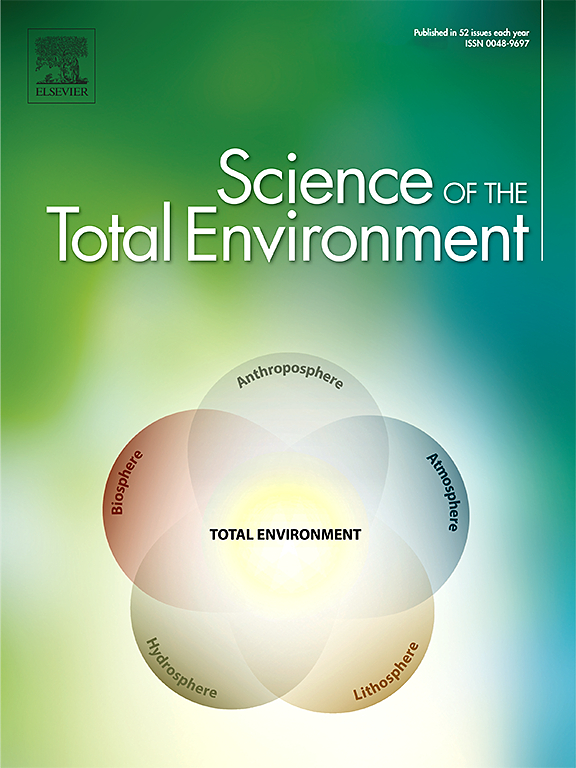Microbial carbon dynamics in tropical forests: linking soil processes to atmospheric impacts under climate stress
IF 8.2
1区 环境科学与生态学
Q1 ENVIRONMENTAL SCIENCES
引用次数: 0
Abstract
Tropical forests are key regulators of the global carbon cycle, yet their stability under climate change remains uncertain due to limited understanding of soil microbial contributions to carbon sequestration and greenhouse gas (GHG) emissions. Microbial communities drive organic matter decomposition, carbon stabilization, and GHG fluxes, making them central to carbon cycling in this ecosystem. This review synthesizes current knowledge on microbial carbon dynamics in tropical forest soils, focusing on how climate-induced stressors such as elevated CO2, warming, and altered precipitation reshape microbial community composition, enzyme activity, and functional capacity. It examines feedbacks between microbial processes and atmospheric carbon, highlighting the dual role of microbes in both carbon sequestration and release. This review also addresses the quantification of microbial carbon pathways using isotopic tracing, soil organic matter fractionation, and molecular techniques to elucidate microbial assimilation, stabilization, and decomposition. Additionally, it explores innovative microbial strategies for carbon stabilization, including microbial engineering, biochar application, microbial-electrochemical systems, and mycorrhizal optimization, which enhance soil organic carbon retention and reduce CO₂ emissions. However, significant knowledge gaps remain, particularly in underrepresented tropical regions and in integrating microbial traits into Earth system models. To bridge these gaps, we propose a research agenda that necessitates long-term field studies, cross-ecosystem comparisons, and advanced molecular and biogeochemical tools to uncover microbial metabolic functions, necromass dynamics, and redox-mediated stabilization mechanisms under shifting tropical forest soil environments.

热带森林微生物碳动态:气候胁迫下土壤过程与大气影响的联系
热带森林是全球碳循环的关键调节器,但由于对土壤微生物对碳固存和温室气体(GHG)排放的贡献了解有限,热带森林在气候变化下的稳定性仍然不确定。微生物群落推动有机物分解、碳稳定和温室气体通量,使其成为生态系统中碳循环的核心。本文综述了热带森林土壤微生物碳动态的最新研究成果,重点介绍了气候诱导的压力因素(如CO2升高、变暖和降水改变)如何重塑微生物群落组成、酶活性和功能能力。它研究了微生物过程和大气碳之间的反馈,强调了微生物在碳固存和释放中的双重作用。本文还介绍了利用同位素示踪、土壤有机质分馏和分子技术来阐明微生物同化、稳定和分解的微生物碳途径的量化。此外,它还探索了碳稳定的创新微生物策略,包括微生物工程,生物炭应用,微生物电化学系统和菌根优化,以增强土壤有机碳保留和减少二氧化碳排放。然而,仍然存在重大的知识空白,特别是在代表性不足的热带地区和将微生物特征纳入地球系统模型方面。为了弥补这些差距,我们提出了一项研究议程,需要长期的实地研究,跨生态系统的比较,以及先进的分子和生物地球化学工具,以揭示热带森林土壤环境变化下的微生物代谢功能,坏死团动力学和氧化还原介导的稳定机制。
本文章由计算机程序翻译,如有差异,请以英文原文为准。
求助全文
约1分钟内获得全文
求助全文
来源期刊

Science of the Total Environment
环境科学-环境科学
CiteScore
17.60
自引率
10.20%
发文量
8726
审稿时长
2.4 months
期刊介绍:
The Science of the Total Environment is an international journal dedicated to scientific research on the environment and its interaction with humanity. It covers a wide range of disciplines and seeks to publish innovative, hypothesis-driven, and impactful research that explores the entire environment, including the atmosphere, lithosphere, hydrosphere, biosphere, and anthroposphere.
The journal's updated Aims & Scope emphasizes the importance of interdisciplinary environmental research with broad impact. Priority is given to studies that advance fundamental understanding and explore the interconnectedness of multiple environmental spheres. Field studies are preferred, while laboratory experiments must demonstrate significant methodological advancements or mechanistic insights with direct relevance to the environment.
 求助内容:
求助内容: 应助结果提醒方式:
应助结果提醒方式:


